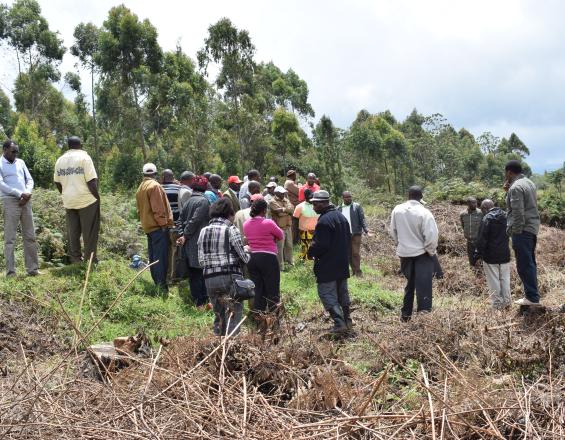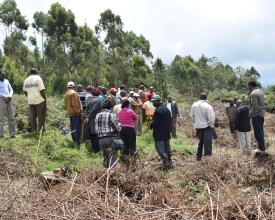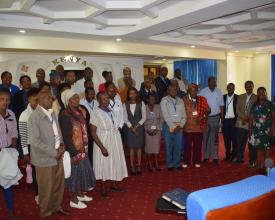Pago por el servicio ecosistémico del agua en el bosque de la escarpa Kikuyu, Kenia.

La Reserva Forestal del Escarpe Kikuyu tiene una superficie de 37.000 hectáreas. Los bosques proporcionan importantes servicios ecosistémicos, entre ellos una cuenca crítica. Sin embargo, la cuenca se enfrenta a una grave amenaza de degradación medioambiental ocasionada por la invasión de las cuencas hidrográficas, lo que provoca estrés hídrico. Con el fin de garantizar una financiación sostenible para la protección de la cuenca forestal, los Voluntarios del Medio Ambiente de Kijabe (KENVO), en colaboración con empresas, administraciones públicas, centros de enseñanza e instituciones comunitarias, pusieron en marcha un sistema de pago por ecosistema acuático (PSE). El PSA del agua pretendía hacer frente a la degradación de la cuenca, la mala gestión de la tierra, los cultivos en las riberas, el aumento de la contaminación del agua y el descenso del nivel del agua en las presas. La solución presenta un plan de pago por los servicios de los ecosistemas hídricos en la cuenca de captación que se extiende a lo largo de 3 años en Kikuyu Escarpment financiado por Critical Ecosystem Partnership (CEPF).
Contexto
Défis à relever
La solución abordaba la falta de un mecanismo de financiación sostenible para el Bosque de la Escarpa Kikuyu. Las instituciones comunitarias río arriba (principalmente las CFA y las WRUA) luchan por proteger los bosques y los ríos con recursos limitados o inexistentes. El proyecto aumentó la financiación del sector privado a través de asociaciones con las Asociaciones Forestales Comunitarias (CFA) para restaurar los servicios ecosistémicos del agua. El objetivo final era beneficiar a la biodiversidad, aumentar la cantidad de agua, reducir la erosión y la sedimentación en los embalses de agua y, en última instancia, reducir la pobreza y otros factores causantes de la pérdida de bosques.
Ubicación
Procesar
Resumen del proceso
La comunidad aguas arriba (productores o encargados de los servicios ecosistémicos) compromete a la comunidad aguas abajo, principalmente las empresas, explotaciones e industrias.
Las instituciones comunitarias son responsables del estado de los bosques y de los servicios que prestan. Las Asociaciones de Usuarios de Recursos Hídricos (AUAH) son responsables del estado de los ríos que nacen en el bosque. Asumen la carga de la conservación de la cuenca forestal.
Por otro lado, la región cuenta con una serie de empresas potenciales río abajo que se benefician del agua de este bosque. Entre ellas están los proveedores de servicios hídricos de las compañías de agua, las plantaciones de té, las explotaciones agrícolas y los procesadores de alimentos, bebidas y leche.
Tanto las comunidades situadas río arriba como las situadas río abajo deben comprometerse a garantizar un suministro sostenible de agua.
Bloques de construcción
Estudio de referencia de la cuenca hidrográfica para elaborar mapas hidrológicos
Se realizó un estudio de referencia sobre la cuenca del Escarpe Kikuyu para elaborar mapas hidrológicos de la zona. El estudio identificó los puntos conflictivos en los que era necesario intervenir, así como los mapas hidrológicos que mostraban la relación entre el curso superior del río y el curso inferior, indicando además las zonas de captación de los principales ríos utilizados por la mayoría de los proveedores de servicios de agua.
Factores facilitadores
KENVO cuenta con una larga experiencia de trabajo en el bosque Kikuyu Escarpment y de colaboración con las principales partes interesadas, como organismos gubernamentales, instituciones de investigación, el sector privado y otros organismos de desarrollo, para informar, educar y capacitar a las comunidades para que adopten prácticas de conservación adecuadas.
Lección aprendida
Es importante reflexionar de forma más crítica sobre cómo justificar el agua como servicio ecosistémico realizando un estudio de referencia. Esto significa conocer el estado de los recursos hídricos y las zonas de intervención antes de iniciar el PSE.
También es necesario comprender los factores de degradación que afectan al servicio que se vende, lo que es vital para diseñar actividades de intervención que convenzan a los compradores potenciales de la capacidad de los vendedores para prestar los servicios prometidos.
Recursos
Movilización y capacitación de las instituciones comunitarias
KENVO movilizó a las instituciones comunitarias (CFA y WRUA) en un grupo organizado y desarrolló su capacidad para participar en el PSE. Además, se concienció a la comunidad sobre las políticas. A fin de reforzar las AFC y las WRUA, se las formó en todos los aspectos relacionados con el PSE: políticas, prácticas, derechos, responsabilidades, gestión de fondos, supervisión y cumplimiento.
Se celebraron consultas comunitarias con los CFA y los WRUA y se elaboraron planes de acción. Los principales objetivos de los planes de acción eran apoyar prácticas de uso de la tierra que mejoren la cantidad y calidad del agua y capacitar a la comunidad local para garantizar la restauración de las cuencas mediante un sistema de pago por servicios de agua.
Factores facilitadores
KENVO estaba dispuesta a intermediar en las relaciones entre la comunidad y las empresas.
Las instituciones comunitarias existían y estaban dispuestas a participar y comprometerse con las empresas.
Lección aprendida
- Las instituciones comunitarias locales, las CFA y las WRUA son una baza para la restauración forestal, ya que disponen de mano de obra suficiente para realizar el trabajo.
- La comunidad local representada por las CFA y las WRUA necesita apoyo para negociar con el sector empresarial.
- Las empresas están dispuestas a trabajar con las instituciones comunitarias locales, las CFA y las WRUA que demuestren capacidad de gestión financiera y cumplimiento de los objetivos previstos.
Creación de asociaciones y alianzas con empresas
Para implicar a las comunidades de la parte baja del río, KENVO preparó documentos de presentación en forma de fichas y documentales para hablar con los posibles compradores de la parte baja del río. KENVO se reunió con los compradores en sus propias oficinas y también les invitó a visitar el KBA y las cuencas forestales. El objetivo era mostrarles de dónde procedía el agua y qué había que hacer para mantener su caudal y calidad. Esto ayudó a los compradores a comprender mejor la importancia del programa de PSE. KENVO identificó compradores potenciales, entre ellos industrias, compañías de agua y plantaciones de té.
En un proceso participativo se elaboró un plan de negocio para el lugar. Los equipos de negociación de la comunidad recibieron formación en técnicas de negociación para aumentar su capacidad de implicar a las empresas.
Factores facilitadores
Disponibilidad de un intermediario
intermediario (KENVO) dispuesto a mediar en las relaciones
Vínculo directo entre las empresas y el agua del bosque
Lección aprendida
Las empresas (usuarios del agua) están dispuestas a colaborar con los "vendedores" siempre que puedan cuantificar los beneficios que obtienen del ecosistema forestal
El sector privado tiene procedimientos financieros estrictos que exigen instituciones creíbles para comprometerse.
Necesidad de reuniones consultivas periódicas entre empresas e instituciones comunitarias
Compromiso con las empresas y solicitud de compromisos de financiación
Para implicar a las empresas, KENVO buscó compromisos estratégicos de los usuarios de los recursos hídricos aguas abajo para apoyar la gestión y protección de las cuencas aguas arriba por parte de la comunidad. Se llevó a las instituciones comunitarias y a las empresas a negociar y acordar sus respectivas funciones y responsabilidades. Cada una de las partes tuvo que comprometerse con su contribución.
Además, se creó una plataforma empresarial a través de la cual la comunidad de aguas arriba se comprometía con las comunidades de aguas abajo. En esta plataforma, las comunidades negociaron un acuerdo con las empresas para comprometerse a proteger y mantener los valores del ecosistema de una superficie acordada de 3.000 hectáreas anuales.
Factores facilitadores
Voluntad entre la comunidad y las empresas para llegar a un compromiso
Disponibilidad de fondos por parte de las empresas
Lección aprendida
Las empresas dudan en comprometerse a financiarse a largo plazo mediante acuerdos contractuales, pero están dispuestas a contribuir de forma insostenible
Para que las empresas apoyen el sistema, es crucial contar con políticas adecuadas de apoyo a los PSE
Las empresas están dispuestas a financiar CSA y WRUA que demuestren capacidad de gestión financiera y cumplimiento de los objetivos previstos.
Las AFC y las WRUA son un activo para la restauración forestal, ya que disponen de mano de obra suficiente para realizar el trabajo.
Impactos
La iniciativa permitió un flujo y una calidad del agua sostenibles para las comunidades, empresas y explotaciones situadas aguas abajo de la cuenca de captación de Kikuyu Escarpment. La cuenca fue restaurada y gestionada de forma sostenible para proporcionar servicios ecosistémicos de agua. La restauración se llevó a cabo mediante la rehabilitación de la cuenca y el fortalecimiento de las instituciones comunitarias (Asociaciones Forestales Comunitarias y Asociaciones de Usuarios de Recursos Hídricos). Las acciones de protección y gestión mejoradas por las partes interesadas y los socios se aplicaron para garantizar beneficios de conservación en 12.000 hectáreas de la escarpa Kikuyu. Esto fue posible gracias a la transferencia de 10.000 dólares por parte de las empresas a las WRUAs y CFAs para proteger la cuenca del Escarpe Kikuyu. Además, un mayor número de empresas adoptaron el sistema de PSE mediante el aumento de las contribuciones financieras para la gestión de la cuenca. Por último, se mejoró la capacidad de las CFA y las WRUA para implicar a las empresas mediante formación en gobernanza, negociación y liderazgo.
Beneficiarios
Los beneficiarios son la comunidad (Asociaciones Forestales Comunitarias, Asociaciones de Usuarios de Recursos Hídricos), las empresas (empresas de servicios de agua, explotaciones agrícolas e industrias aguas abajo), el Gobierno (nacional y de condado) y el Servicio Forestal de Kenia.
Objetivos de Desarrollo Sostenible
Historia

Los bosques de Kikuyu Escarpment se encuentran a 50 km al noroeste de Nairobi, Kenia. Dentro del bosque de la Escarpa Kikuyu hay una serie de reservas forestales que cubren 37.000 hectáreas, lo que lo convierte en una de las principales zonas forestales de Kenia. Los bosques proporcionan importantes servicios ecosistémicos: culturales, suministro de agua, productos y regulación del clima. El bosque forma la cuenca superior de los principales ríos keniatas.
A pesar de la importancia de la cuenca, se enfrentaba a una serie de amenazas. La situación se caracterizaba por actividades humanas insostenibles que degradaban la cuenca y reducían su valor medioambiental. A raíz de ello, el bosque se vio sometido a presiones cada vez mayores provocadas por la invasión de las cuencas hidrográficas, el pastoreo excesivo, las malas prácticas agrícolas, la extracción de productos forestales, el cultivo en zonas ribereñas y la escasa aplicación de la normativa, entre otros factores.
La situación tuvo consecuencias imprevistas, entre ellas la reducción del caudal aguas abajo, la contaminación de los ríos, la coloración del agua (turbidez), la sedimentación en las presas y los ríos, la reducción de la cantidad de agua en las presas de los embalses, la erosión aguas arriba y las enfermedades transmitidas por el agua. Las consecuencias las sufrieron las comunidades río abajo, principalmente las industrias, los agricultores y la ganadería. Otras consecuencias río abajo fueron la competencia y los conflictos por los recursos hídricos entre animales, agricultores e industrias. También provocó el racionamiento del agua y el elevado coste del tratamiento del agua para las industrias y los proveedores de servicios hídricos.
En sus actividades de conservación se descubrió que el servicio ecosistémico del agua es fundamental para todas las formas de vida y comunidades río abajo. La disminución del agua hizo que las partes interesadas se unieran para invertir la tendencia, por lo que KENVO inició el pago por el servicio ecosistémico del agua con el apoyo del Fondo de Cooperación para los Ecosistemas Críticos (CEPF).
La iniciativa de pago por servicios ecosistémicos del agua garantizó que las comunidades implicadas en la gestión, conservación y protección de la cuenca recibieran un pago de los beneficiarios de los servicios de la cuenca. De este modo, se pretende establecer una relación comercial entre los productores de servicios ecosistémicos (la comunidad) y los beneficiarios (las industrias aguas abajo) en beneficio mutuo.









